Whether you’re an intrepid overlander exploring remote locations, an avid adventurer seeking the thrill of whitewater rafting, or a beachgoer looking to keep your valuables safe from sand and surf, dry bags have become an indispensable companion for outdoor enthusiasts. Unsurprisingly, these versatile, waterproof wonders have revolutionized how we protect our gear from the elements.
When searching for the right dry bag, consider the size requirements, material, type of closure, and waterproof rating. The bag’s capacity should be chosen based on the amount of gear you need to carry. The fabric and construction must be durable enough to withstand demanding use—not to mention sustained wind shear when strapped to luggage racks, extended exposure to the elements, and protection from harsh UV rays.
The bag’s available lash points also factor into the decision-making process. When packed inside the cabin, proper stowage and securing of gear are paramount with regard to the safety of the occupants. When secured outside, say tied to a roof rack or in a river raft, losing your stuff is not an option. On top of everything else, dry bags earn sustainability bonus points if the fabrics are free of toxic chemicals and made from recycled materials.
Outdoor dry bags are designed to seal out moisture and air, creating a waterproof and dustproof barrier that keeps your belongings safe and dry. They are usually made of durable, coated fabrics like vinyl, polyester, or Cordura. Look for radio-frequency (RF)-welded rather than sewn-and-taped seams as they provide an airtight seal with the best strength and resilience.
The third part of the protection equation is the type of airtight or water-resistant closures used. The most common type of closure is a roll-top that incorporates a strip of reinforced material. Fill the bag no more than three-quarters of its capacity and purge the excess air from the dry bag. Create a watertight barrier by rolling the top a minimum of three times and clipping the buckles together. Dry bags that use water-resistant or waterproof zippered systems are convenient to open and close. The third method of closure, used by companies such as Watershed, is a ziplock-style seal that’s 100 percent waterproof, providing a tighter seal when under pressure.
With this in mind, many brands, such as the Yeti Panga below, will claim their dry bags meet some level of IP protection class. Check the waterproof rating, which indicates how well the bag can keep water out or if it is fully submersible.
Additional factors to take into account when choosing an outdoor dry bag include the shape, weight, capacity, and price. You also need to think about how often and where you will use it and what kind of items you will store. For example, if you are going on a long trip with a lot of gear, you might want a large, sturdy bag that can fit everything. On the other hand, if you are out kayaking or paddle boarding for the day, you might prefer a smaller, lighter one that is easy to carry and pack.
We field-tested some of the most popular and highly rated products to help you find the best outdoor dry bag for your next adventure. Here are our top picks.
Best Valve/Compression Dry Bag
SealLine Discovery Deck Dry Bag, 20L
Material: 18-ounce, 300-denier, PU-coated polyester
Protection level: Waterproof
Weight: 1.1 pounds
Dimensions: 10 x 6 x 21 inches
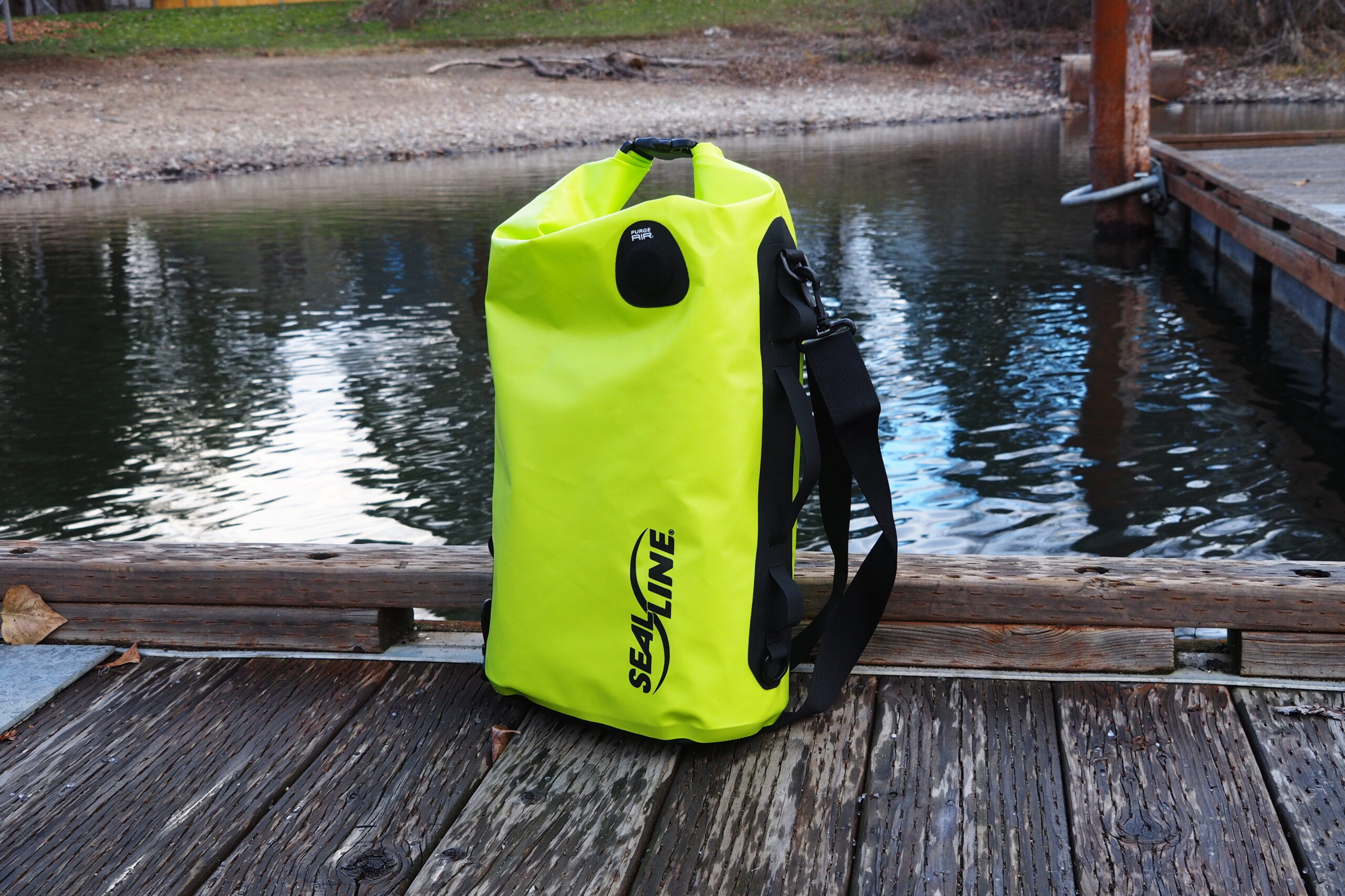
The SealLine Discovery Deck is a sturdy, versatile compression bag with a one-way purge valve for maximum space savings and is available in four bold colors and three sizes (10, 20, or 30 liters). Construction quality and RF-welded seams add up to a reliable carry-all that provides ideal water protection and remarkable durability for its size and weight. The oval base provides additional stability, and the thick material is free of PVC chemicals and easily repels water; it’s also resistant to snags or tears when dragged across sharp surfaces. The Discovery Deck uses a patented DrySeal roll-top closure that proved effective at preventing water and dust from seeping into the bag. Fold the bag tightly between the two black sealing straps at least three times to ensure a foolproof seal. Pushing down on the bag will expel the excess air as much as desired. Snap the buckles together to make it fully waterproof.
Oftentimes, the Discovery Deck was my go-to sack for warm, lazy afternoons spent paddle boarding on the water. The detachable shoulder strap added another convenient carry option, plus four D-rings and numerous loops made tethering a cinch. Not only was the purge valve a no-brainer to operate, but it didn’t require manual engagement to evacuate the right amount of excess air. Altogether, I appreciated the Discovery Deck’s ability to keep my gear dry when a not-too-big, not-too-small bag is needed, and the light-colored interior made it easy to locate items in a pinch. Made in the USA.
$65 | seallinegear.com
Pros
- RF-welded seams
- Purge valve placement
- Light-colored interior
- Stable shape
Cons
- Costs more than some competitors
Exped Waterproof Compression Bag, 19L
Material: 70-denier, PU-coated taffeta nylon, Oeko-Tex Standard 100 certified
Protection level: Waterproof
Weight: 3.2 ounces
Dimensions: 20.5 x 8.7 inches

Among its outstanding strengths, Exped’s versatile compression dry bag features three horizontally oriented cinch straps to consolidate and stabilize gear. The straps are easy to cinch up when squeezing excess air out and allow the bag to be packed vertically or horizontally—or strapped to the outside of a backpack. Organizing gear inside a backpack is almost like a game of Tetris, but Exped’s dry bag ensures maximum space and weight efficiency. The white-colored interior lining makes it easy to find things, and its sleek texture was a characteristic I welcomed when packing the sleeping bag. The bag weighs almost nothing and does an excellent job of preventing the invasion of moisture and dust.
Available in three color pairings, the exterior fabric is Oeko-Tex Standard 100 certified, free of toxic chemicals for peace of mind. The taped seams are stitched well and hold up to rigorous stuffing and squeezing. After rolling the top closure at least three times, the trapped air inside the bag exits through a purge valve. Pull the cap off, compress the dry bag, and the one-way valve releases the excess air. Features I often look for in dry bags that are missing from Exped’s waterproof compression bag are welded seams and external lash points.
Bonus feature: Attach Exped’s Schnozzle (optional accessory) for double-duty performance, transforming this dry bag into a pump bag for Exped’s sleep mats, ensuring moisture-free air without huffing and puffing. It’s not useful for everyone, but it’s a saving grace and worth the extra cost, especially at high elevations.
$43 | expedusa.com
Pros
- Feathery weight
- Compression straps
- White interior lining
- Oeko-Tex Standard 100 certified
Cons
- Seams not welded
- Missing anchor points
Best Lightweight Dry Bag
Sea to Summit Lightweight, 35L
Material: PFC-free, Bluesign-approved, recycled 70-denier nylon
Protection level: Waterproof
Weight: 4.1 ounces
Dimensions: 12.4 x 11.3 x 21.9 inches

Sea to Summit is a trusted brand for dry bags, and its Lightweight model is perfect for organizing clothing, carrying precious gear, or strapping to a paddle board. Apart from its ultralight construction and light-duty purpose, the oval base allows for proficient packing and prevents a roll-away bag. The reinforced bottom sits flat and has an integrated lash loop, and the fabric’s seams are strong enough to withstand the pressure when compressing the bag—along with taking some abuse. After sitting outside in the rain for two straight days with numerous dunkings into lakes and rivers, it proved to have one of the best waterproof roll-top seals I tested in its class. The inner polyurethane (PU) coating is also waterproof and bright white, and the slick interior fabric makes it much simpler to find things when rummaging for a specific item, especially since there are no internal organization pockets. The snap buckle has a D-ring, serving as a handy anchor point or for clipping on a carabiner.
Although submersing the Lightweight into a lake isn’t recommended, it will keep your stuff dry for every other possible scenario that doesn’t involve dragging it underwater. When empty, it rolls up for easy, compact storage. By far, the Sea to Summit Lightweight dry bag is the most functional and versatile in its class. It’s available in seven sizes ranging from 1.5 to 35 liters with five bright colors for easy visibility.
$35 | seatosummit.com
Pros
- Easy to use
- Proficient water protection
- Replaceable clip
- Light-colored interior
Cons
- Light-duty use only
- No interior pockets
- Seams not welded
Ortlieb Dry-Bag PS10 Valve, 22L
Material: PS10 nylon fabric
Protection level: Waterproof
Weight: 3.8 ounces
Dimensions: 16.5 x 10.4 inches
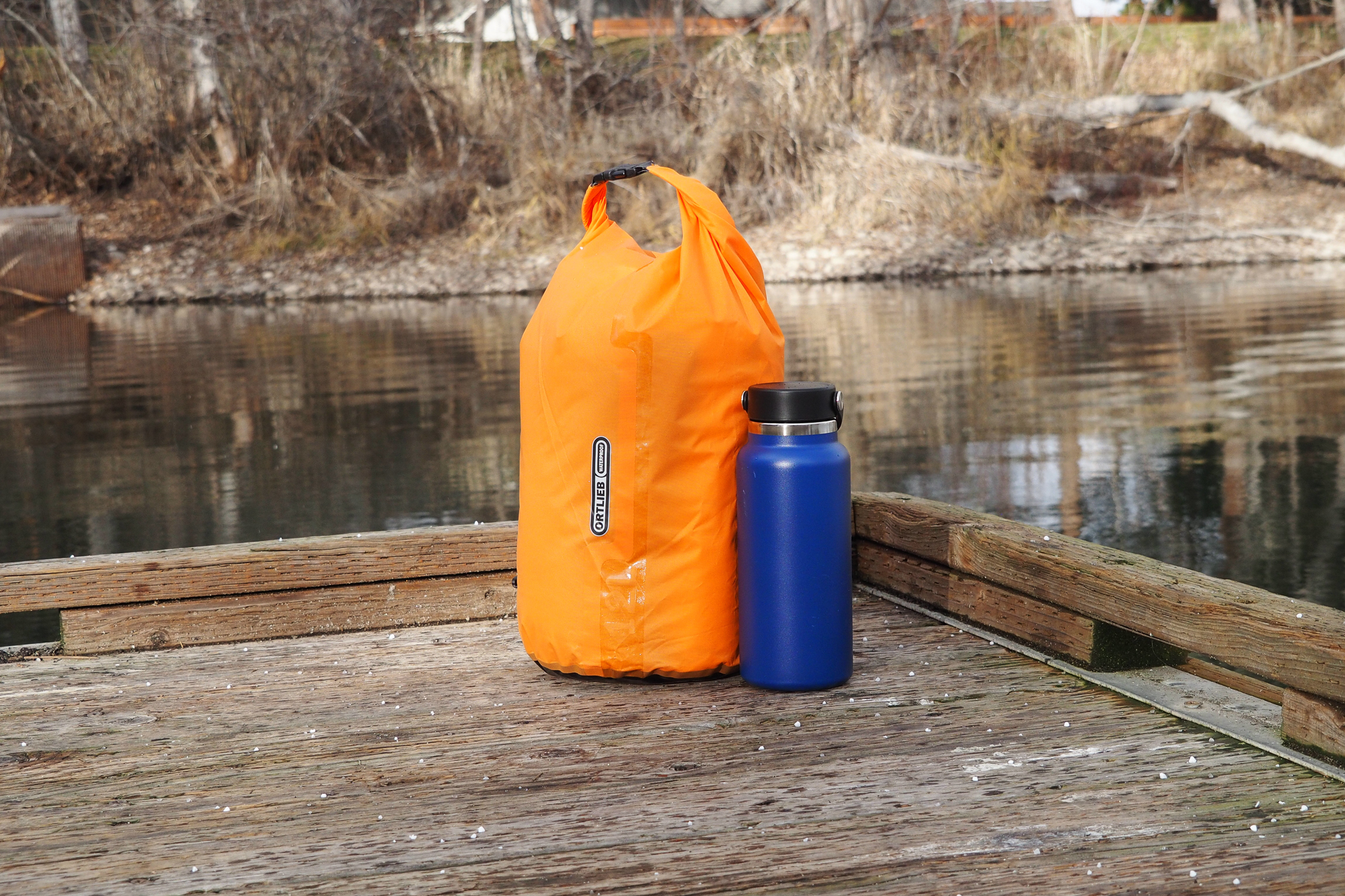
Ortlieb, based in Germany, may not have the name recognition on the level of Yeti or Sea to Summit, but the construction and waterproofing of their dry bags are on par with any of the leading brands and display skilled craftsmanship that achieves a high level of recognition anywhere in the world.
This Ortlieb dry bag is a prime example of a lightweight item that serves well when packing for any overland or backpacking trip. The choice of three colors and three capacity options (7, 12, or 22 liters) make it easy to organize by color and size, and the robust base fabric is abrasion and tear-resistant. The seams are high-frequency welded to ensure there aren’t any weak points when compressing or the possibility of seepage. The purge valve efficiently releases excess air when squeezing the dry bag, but I had to use one hand and manually press the valve.
I found the 22-liter size is aptly suited for compressing most sleeping bags. Aside from the external grab handle at the bottom, the PS10 had no D-rings or obvious anchor points. Bear in mind that lightweight dry bags are designed for light duty. In other words, don’t count on it to hold up to prolonged exposure to water or being poked with a sharp object. Thankfully, I didn’t experience any rips or tears. Then again, I didn’t subject the PS10 to any torture tests.
$44 | ortlieb.com
Pros
- High-frequency welded seams
- Second lightest bag in test
Cons
- Must roll 5-6 times for proper water protection
- Purge valve isn’t the easiest to operate
- No D-rings or anchor points
Best Thick Dry Bag
Fishpond Thunderhead Submersible, 39L
Material: 900-denier, TPU-coated, NewStream recycled fabric
Protection level: Submersible
Weight: 3.25 pounds
Dimensions: 21 x 12.5 x 11 inches
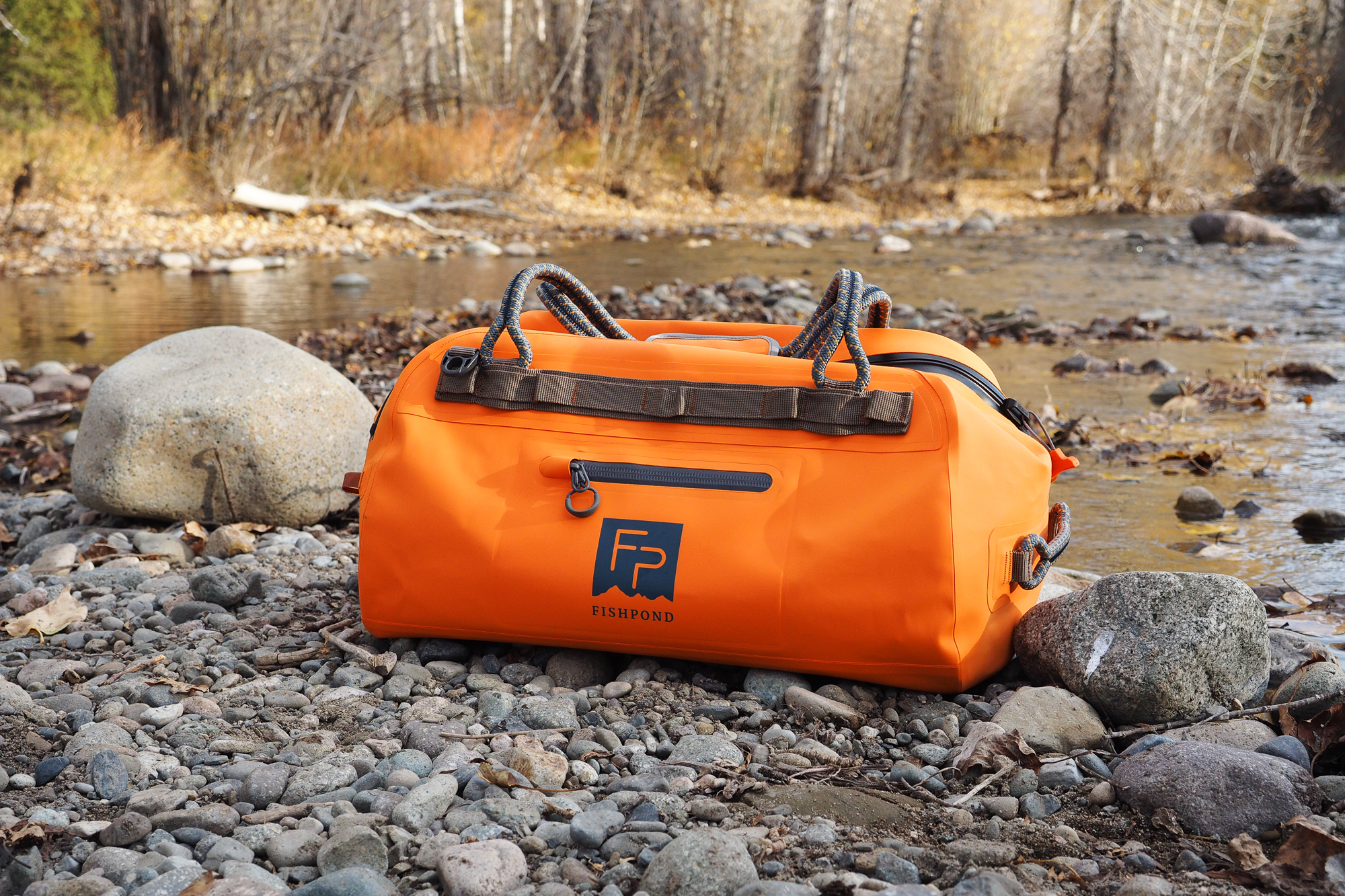
We all love gear. I love gear—maybe too much. Regardless, the Fishpond Thunderhead has become a favorite must-have for keeping my stuff dry. It’s 100 percent waterproof and bombproof with a size and weight that isn’t a bear to lug around. It held up to being tossed off of boats, shoved under fallen timber with potentially fabric-piercing branches, and has survived the abuse brought on by baggage handlers at airports.
The shell is thick like Rhino Skin and takes on the worst conditions Mother Nature can summon up without fail. Constructed using Fishpond’s NewStream material made from 100 percent recycled, single-use plastic water bottles, your important stuff stays dry and clean—even when completely submerged underwater. The bottom is even tougher, made from EVA-molded, abrasion-resistant material so that it could survive a 15-foot drop on a bed of sharp lava rock, and you wouldn’t give it a second thought.
The diagonal placement of the TruZip waterproof zipper makes it easier to pack and remove things later. The zipper action is smooth but requires a little bit of arm strength. Hence, gripping the small loops (placed at both ends) assists with opening and closing. Since the zipper is self-healing, pulling it back and forth a couple of times will make it better if things get wonky. The designers thoughtfully integrated a generous number of heavy-duty anchor points on the Thunderhead, with thick rope grab handles fore and aft, plus numerous strap loops flanking the sides—all of which benefit from reinforced stitching. This dry bag employs a ruggedness and protection that won’t fail you under extreme conditions.
$300 | fishpondusa.com
Pros
- Highly durable fabric
- Thoughtful grab loops facilitate opening/closing
- Diagonal opening for better access
Cons
- Zipper requires significant force to move
- Only available in orange
Ortlieb Dry-Bag PS490, 35L
Material: PS490, PD620
Protection level: Waterproof
Weight: 1 pound
Dimensions: 23 x 10 x 32 inches (H x D x C)
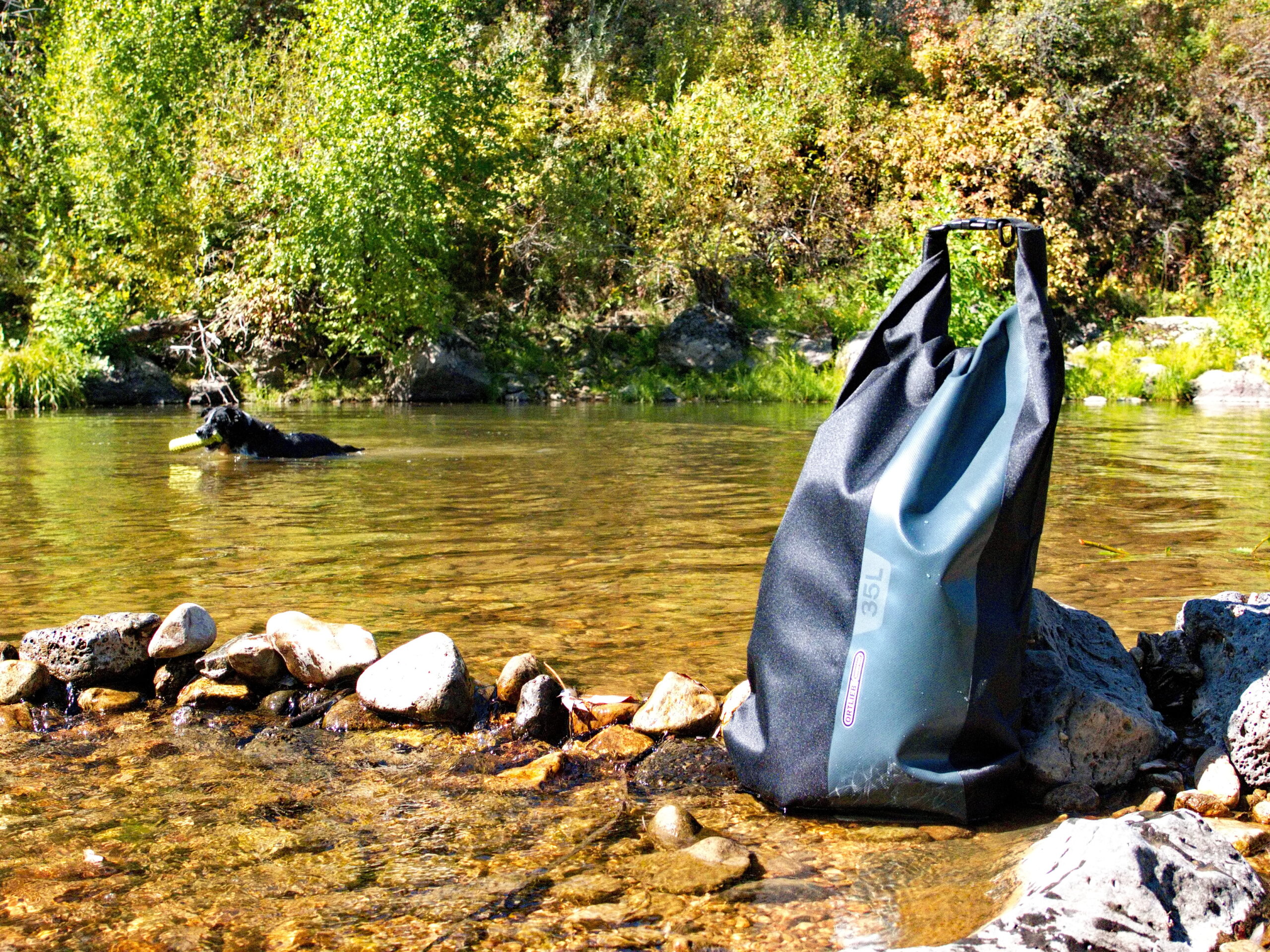
The PS490 uses Ortlieb’s most robust, heavy-duty fabrics (PVC-coated polyester) designed for extreme activities. It features a roll-down closure with a stiffener bar, multiple D-rings, and a rugged base made of abrasion-resistant PD620 material. The flat bottom incorporates a small loop big enough to fit three fingers, giving the bag three external anchor points. A voluminous interior on the 35-liter dry bag fits anything from a sleeping bag to several days of clothing changes. Still, the dark interior color makes finding a specific piece of gear challenging, and an internal organizational pocket would be welcome. High-frequency-welded seams contribute to the dry bag’s strength and resistance to leaking under pressure. Essentially, it ensures that everything inside stays dry and free from dust.
The PS490 has an excellent durability-to-weight ratio; the fabric is strong enough to last through years of use but nowhere near as heavy as a 900-denier or 800-denier fabric. Strapped to a rooftop luggage rack for a weeklong trip from Idaho to Arizona and back, the PS490 retained its totality after prolonged exposure at highway speeds. Nor did it allow a wick of moisture to seep in on rainy days or in a wet, slushy snowstorm in the high mountain passes near Flagstaff.
While it rests in the upper price range of durable dry bags, the PS490 is worth every penny. One size doesn’t fit all, so the PS490 is available in six sizes, ranging from 13 to 109 liters. An additional side handle is featured on the larger sizes, starting at 59 liters.
$48 | ortlieb.com
Pros
- Convenient to grab and pack
- Simple, functional design
- High-frequency-welded seams
Cons
- Internal pocket missing from larger sizes
- Dark interior color
- Only available in black
Best Duffel Dry Bag
Watershed Colorado Duffel, 75.5L
Material: Kryptothane Plus 840-denier PU-coated ripstop nylon
Protection level: Submersible
Weight: 3.7 pounds
Dimensions: 27 x 7 x 5 inches
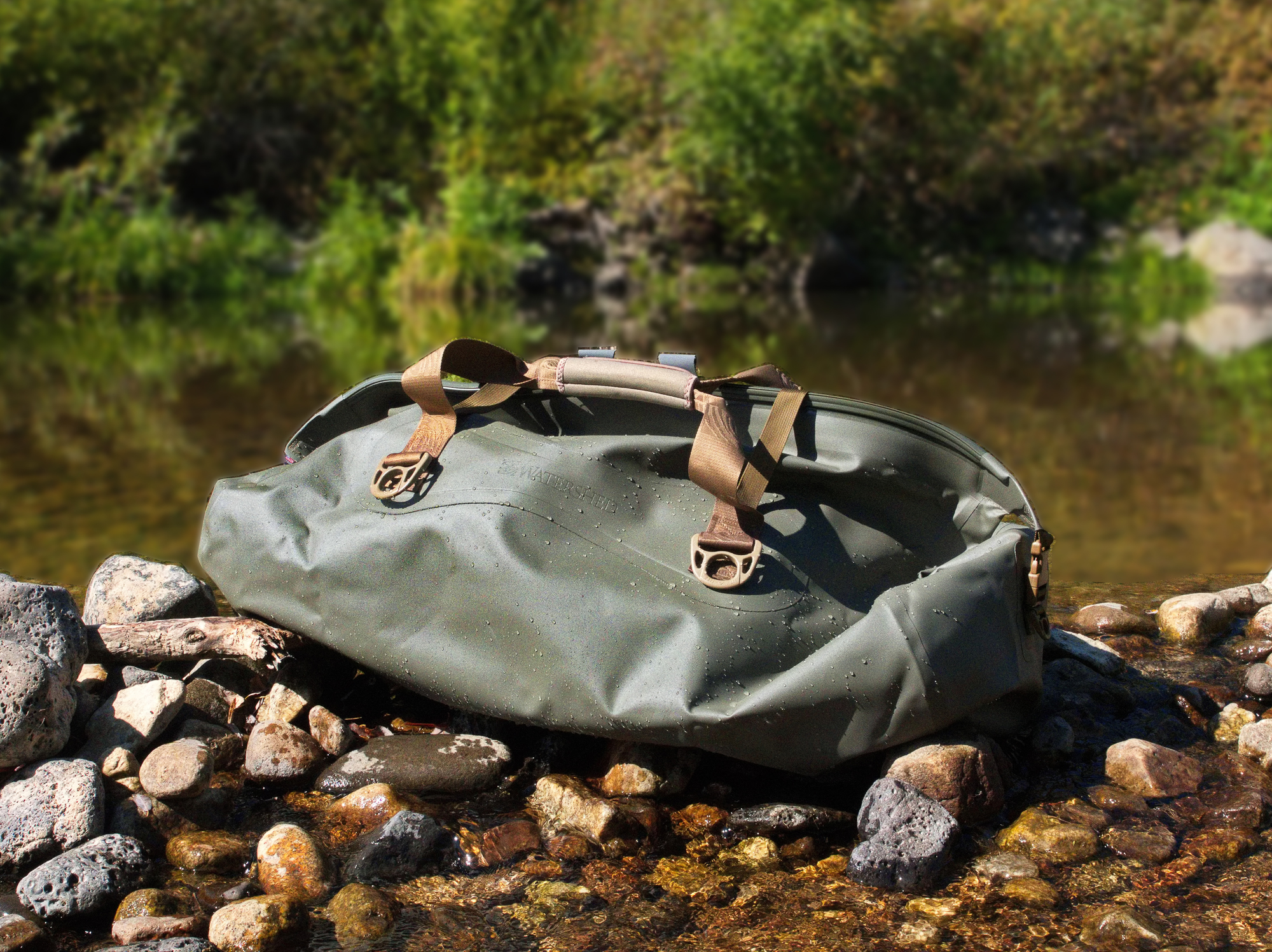
Watershed dry bags were designed by river guides unimpressed by the lack of options available at the time to meet the rigors of all levels of whitewater classifications. After two years of development and testing, Watershed’s Colorado received a significant material upgrade using the company’s new Kryptothane Plus fabric, emphasizing a thicker, grippier PU coating and high resistance to UV rays. The fabric was nearly impervious when it encountered jagged rocks on whitewater rafting trips, and it didn’t show a sign of shredding after hours of highway driving strapped to the rooftop. It’s highly pliable, allowing for compact packing into tight spaces.
Learning how to use the ziplock-style ZipDry closure system required a little practice. Though slightly inconvenient, its airtight seal works better than bags with roll-top closures, and it will retain its ability to keep out water as zippers sometimes break or deform over the years. Another advantage is the absence of zipper teeth to snag and tear expensive clothing.
The Colorado’s tie-down is easy. Six sturdy D-rings on the front, rear, and sides allow for strapping the dry bag onto a rack. Double- and triple-layer fabric at meeting points and RF-welded seams add to the bag’s integrity. Its 75.5-liter capacity is large enough to carry one person’s gear on a multi-day adventure. It also excels as a temporary storage bag for separating wet or muddy gear. I often ride with a buddy, and the Colorado can hold my fishing waders or wet ski boots, thereby avoiding dirtying my friend’s vehicle. Available in four colors and made in the USA.
$269-$370 (dependent on fabric) | drybags.com
Pros
- End-to-end opening for full access
- RF-welded seams
- Waterproof ZipDry closure
- Value
Cons
- Big size
- Awkward to carry
Yeti Panga, 75L
Material: ThickSkin high-density nylon
Protection level: Submersible
Weight: 6.1 pounds
Dimensions: 29.5 x 15.5 x 11 inches
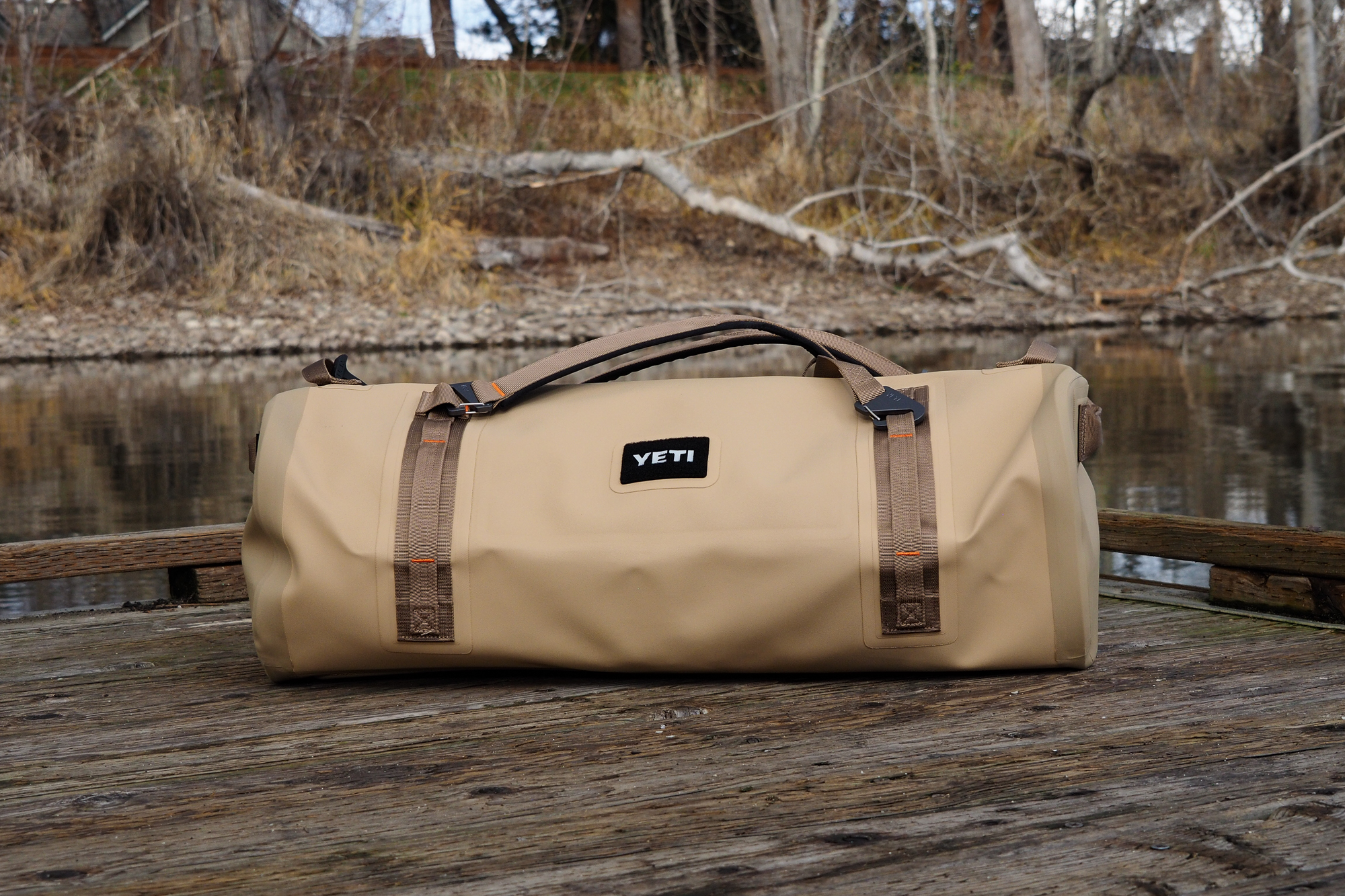
It’s hard to ignore the 250-pound gorilla in this space, but that’s how impressive the Yeti Panga rolls. By design, Yeti products are overbuilt and carry a hefty price tag; however, you can’t dispute the quality and bulletproof durability. The Panga is a watertight, easy-to-pack duffel bag with a waterproof zipper closure, numerous attachment points, two internal mesh pockets, and removable carry handles. It comes in 50-, 75-, and 100-liter sizes and three color choices.
The Panga’s puncture-resistant ThickSkin exterior shell, designed for expedition-level travel, exudes a ruggedness that scoffs at water drenchings, abrasion, or whatever abuse you can dish out. An IPX7 rating and HydroLok zipper ensure everything inside stays dry and clean—even when the bag is submerged. Moreover, the reinforced bottom panel resists wear from dragging and hauling.
Four grab handles (two at each end) plus four vertically stitched strap loops on the side panels present ample points for lashing and anchoring the bag during transit. The detachable dual carry straps are padded and conveniently function as shoulder straps so that the Panga can be worn as a backpack, compensating for its weight. The 75-liter duffel is a trusted adventure bag large enough to fit enough gear for a multi-day trip to my favorite remote destination. Other Yeti owners I spoke with who have made wilderness trips to Alaska and Patagonia and multi-day expeditions along the Great Divide attest to the Panga’s robustness and accomplished ability to keep out the elements. [See Ashley Giordano’s take in “Leaders of the Pack.”]
$350 | yeti.com
Pros
- Tough exterior shell
- EVA molded bottom
- Dual shoulder straps
Cons
- Premium price tag
- Heavy
- Zipper can snag or rip expensive clothing
Best Backpack Dry Bag
Fishpond Wind River Roll-top Backpack, 38L
Material: 900-denier, TPU-coated, NewStream recycled fabric
Protection level: Waterproof
Weight: 3.6 pounds
Dimensions: 24 x 12 x 8 inches (when rolled)

Fishpond’s Wind River offers the ultimate water protection for your next outdoor activity. Construction is an ultra-durable, recycled fabric (available in two colors) that’s waterproof and highly resistant to tears or rips. Plus, I loved the feel of the texture, which surpasses any PU-coated material. The 38-liter capacity is spacious enough to accommodate multiple clothing layers, assorted essentials, and gadgets. The side-mounted belt straps, used for holding fishing rods and accessories, are perfect for river waders who prefer having all of their necessary gear within reach.
With a keen design toward ergonomics, the Wind River has some notable features. The molded, padded backrest allows air between your back and the backpack, reducing heat buildup on long hauls and warm days. For good measure, a generous number of adjustments and straps add to the backpack’s versatility and will fit most body types. Removing the lumbar support belt is a snap for those who find it more of a hindrance than beneficial. The bottom could have benefitted from a treatment like the Thunderhead’s abrasion-resistant molded pad. Nonetheless, it’s not a critical sticking point since the NewStream fabric demonstrated its toughness and ability to repel water after enduring a battery of field tests. The only drawback of an otherwise brilliant waterproof backpack is the thin padding of the shoulder straps. Thankfully, the adjustable waist and sternum straps helped distribute the weight, reducing fatigue and allowing unhindered mobility. After several fishing trips and a few fun days at the river, it excelled in keeping everything inside dry and free from exposure to the elements.
$230 | fishpondusa.com
Pros
- Highly durable fabric
- Strong ergonomic features
- Adjustable/detachable lumbar support belt
Cons
- Unreinforced bottom panel
- Thinly padded shoulder straps
SealLine Pro Dry Pack, 70L
Material: PVC-free, 400-denier, 20-ounce, PU-coated nylon (sides) / 600-denier, 17-ounce, PU-coated polyester (bottom)
Protection level: Waterproof
Weight: 4.75 pounds
Dimensions: 17.5 x 9 x 27 inches

Oh, the weather outside is frightful. But my gear is dry and delightful. And since we have places to go, let it pour, let it pour, let it pour. From motorbiking cross country to trekking across the Patagonia mountains, the Pro Dry Pack will withstand your next epic adventure and last for many more. Available in three colors with an additional 120-liter size, the Pro’s PU-coated nylon and reinforced bottom have a plasticky look and feel, but not a drop of water soaked through after some river wading, a few dips in the lake, and rain exposure for two consecutive days. The material also has a high tear threshold and barely showed signs of wear after months of testing.
Comfort is crucial on long excursions when carrying significant amounts of gear; the padded backrest promotes airflow and is split into sections for upper and lower back relief. The upper panel of the backrest has changeable positions for different body types—a welcome feature since my torso length is on the shorter side. Plus, the densely padded shoulder straps ease the heavy burden of a long day. The single-compartment interior meant I had to use multiple smaller bags to compensate since there were no internal or external pockets. A split reinforcement strip enhances the dry bag’s roll-top closure system. Like most backpacks, a handy carry handle is at the top for easy grab-and-go, and its 70-liter cavernous capacity means you can fill it with enough gear for a multi-day trip in the rainforest and ensure everything stays dry.
$315 | seallinegear.com
Pros
- Cavernous volume
- Back panel adjusts to different torso lengths
- Reinforced bottom
Cons
- Pricey
- Plasticky material
- No pockets
NRS Expedition DriDuffel, 70L
Material: PVC-free, UV-resistant, TPU-coated, 840-denier nylon
Protection level: Submersible
Weight: 2.5 pounds
Dimensions: 28 x 15.25 x 11.75 inches

Northwest River Supplies (NRS) is a renowned provider of gear for outdoor activities, including camping, fishing, kayaking, and rafting. NRS’s new 2024 model of the Expedition DriDuffel represents an improved PVC-free, dual-coated TPU nylon fabric and new color options (four). However, the pre-production sample I received didn’t have the final features of the 2024 model, and my time with it was limited.
Available in 12-, 35-, 70-, and 105-liter sizes, the 70-liter Expedition DriDuffel is remarkably lightweight for its size and 40 percent lighter than the outgoing model. The wide-mouth opening makes it ideal for overlanders who want to pack everything without being weighed down, and compression straps and external guide loops stabilize gear.
The TruZip toothless zipper provides a 100 percent waterproof and dustproof seal that won’t snag or tear delicate clothing. RF-welded seams and its IPX7 submersible rating emphasize the bag’s overall quality. Not to be overlooked, the bag’s flat bottom, webbing chains, sturdy grab handles, and numerous lash points offer versatility in securing it for transport across land or sea.
Sealing against water and dust wasn’t a problem for the Expedition, which performed admirably in the rain soak test, keeping its contents dry and moisture-free over two days of exposure. Because the pre-production sample eventually had to go back to NRS, it wasn’t subjected to any torture tests.
Overall, the NRS Expedition is a standout product that lives up to the company’s reputation for quality. Its durable construction and thoughtful features make it an excellent choice for anyone needing a dustproof and waterproof duffel bag for their overlanding adventures.
$ 330 | nrs.com
Pros
- Lightweight
- RF-welded seams
- TruZip closure
Cons
- Small grip tabs for opposing zipper pull
- No reinforced bottom
Our No Compromise Clause: We do not accept advertorial content or allow advertising to influence our coverage, and our contributors are guaranteed editorial independence. Overland International may earn a small commission from affiliate links included in this article. We appreciate your support.


